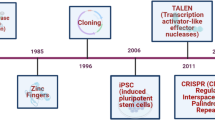Abstract
The complete CDS sequences of three porcine genes: UCHL3, RIT1 and CCND3 were amplified using RT-PCR based on the sequence information of the mouse or other mammals and referenced highly homologous pig ESTs. Sequence analysis of these three genes revealed that the porcine UCHL3 gene encodes a protein of 230 amino acids and has high homology with the ubiquitin carboxyl-terminal hydrolase isozyme L3 (UCHL3) of four species—bovine (97%), human (96%), mouse (95%) and rat (94%). The porcine RIT1 gene encodes a protein of 219 amino acids and has high homology with the GTP-binding protein Rit1 (RIT1) of two species—human (97%), mouse (97%). The porcine CCND3 gene encodes a protein of 292 amino acids and has high homology with the G1/S-specific cyclin-D3 (CCND3) of four species—bovine (98%), human (97%), mouse (93%) and rat (92%). The phylogenetic tree analysis revealed that the swine UCHL3 has a closer genetic relationship with the UCHL3 of bovine, and the swine RIT1 has closer genetic relationships with the RIT1 of human, but the swine CCND3 has a closer genetic relationship with the CCND3 of bovine. The RT-PCR gene expression analysis indicated that the swine UCHL3, RIT1 and CCND3 genes were differentially expressed in tissues including small intestine, large intestine, liver, muscle, fat, lung, spleen and kidney. Our experiment established the primary foundation for further research on these three swine genes.












Similar content being viewed by others
References
Wada H, Kito K, Caskey LS, Yeh ET, Kamitani T (1998) Cleavage of the C-terminus of NEDD8 by UCH-L3. Biochem Biophys Res Commun 251(3):688–692
Nam MJ, Madoz-Gurpide J, Wang H, Lescure P, Schmalbach CE, Zhao R, Misek DE, Kuick R, Brenner DE, Hanash SM (2003) Molecular profiling of the immune response in colon cancer using protein microarrays: occurrence of autoantibodies to ubiquitin C-terminal hydrolase L3. Proteomics 3(11):2108–2115
Wilkinson KD, Lee KM, Deshpande S, Duerksen-Hughes P, Boss JM, Pohl J (1989) The neuron-specific protein PGP 9.5 is a ubiquitin carboxyl-terminal hydrolase. Science 246(4930):670–673
Wood MA, Kaplan MP, Brensinger CM, Guo W, Abel T (2005) Ubiquitin C-terminal hydrolase L3 (Uchl3) is involved in working memory. Hippocampus 15(5):610–621
Sano Y, Furuta A, Setsuie R, Kikuchi H, Wang YL, Sakurai M, Kwon J, Noda M, Wada K (2006) Photoreceptor cell apoptosis in the retinal degeneration of Uchl3-deficient mice. Am J Pathol 169(1):132–141
Semenova E, Wang X, Jablonski MM, Levorse J, Tilghman SM (2003) An engineered 800 kilobase deletion of Uchl3 and Lmo7 on mouse chromosome 14 causes defects in viability, postnatal growth and degeneration of muscle and retina. Hum Mol Genet 12(11):1301–1312
Shi GX, Andres DA (2005) Rit contributes to nerve growth factor-induced neuronal differentiation via activation of B-Raf-extracellular signal-regulated kinase and p38 mitogen-activated protein kinase cascades. Mol Cell Biol 25(2):830–846
Wes PD, Yu M, Montell C (1996) RIC, a calmodulin-binding Ras-like GTPase. EMBO J 15(21):5839–5848
Li JT, Liu W, Kuang ZH, Zhang RH, Chen HK, Feng QS (2004) Mutation and amplification of RIT1 gene in hepatocellular carcinoma. Zhonghua Yi Xue Yi Chuan Xue Za Zhi 21(1):43–46
Hoshino M, Yoshimori T, Nakamura S (1992) Small GTPase proteins Rin and Rit Bind to PAR6 GTP-dependently and regulate cell transformation. J Biol Chem 280(24):22868–22874
Motokura T, Keyomarsi K, Kronenberg HM, Arnold A (1992) Cloning and characterization of human cyclin D3, a cDNA closely related in sequence to the PRAD1/cyclin D1 proto-oncogene. J Biol Chem 267(28):20412–20415
Cooper AB, Sawai CM, Sicinska E, Powers SE, Sicinski P, Clark MR, Aifantis I (2006) A unique function for cyclin D3 in early B cell development. Nat Immunol 7(5):489–497
Kasugai Y, Tagawa H, Kameoka Y, Morishima Y, Nakamura S, Seto M (2005) Identification of CCND3 and BYSL as candidate targets for the 6p21 amplification in diffuse large B-cell lymphoma. Clin Cancer Res 11(23):8265–8272
Tanami H, Tsuda H, Okabe S, Iwai T, Sugihara K, Imoto I, Inazawa J (2005) Involvement of cyclin D3 in liver metastasis of colorectal cancer, revealed by genome-wide copy-number analysis. Lab Invest 85(9):1118–1129
Smith ML, Arch R, Smith LL, Bainton N, Neat M, Taylor C, Bonnet D, Cavenagh JD, Andrew Lister T, Fitzgibbon J (2005) Development of a human acute myeloid leukaemia screening panel and consequent identification of novel gene mutation in FLT3 and CCND3. Br J Haematol 128(3):318–323
Osawa Y, Wang YL, Osaka H, Aoki S, Wada K (2001) Cloning, expression, and mapping of a mouse gene, Uchl4, highly homologous to human and mouse Uchl3Biochem. Biophys Res Commun 283(3):627–633
Inaba T, Matsushime H, Valentine M, Roussel MF, Sherr CJ, Look AT (1992) Genomic organization, chromosomal localization, and independent expression of human cyclin D genes. Genomics 13(3):565–574
Xiong Y, Menninger J, Beach D, Ward DC (1992) Molecular cloning and chromosomal mapping of CCND genes encoding human D-type cyclins. Genomics 13(3):575–584
Liu YG, Xiong YZ, Deng CY, Zuo B, Zhang JH (2004) Comparison of gene expression patterns in Longissimus dorsi of pigs between the high-parent heterosis cross combination Landrace × Large White and the mid-parent heterosis cross combination Large White × Meishan. Asian-Aust J Anim Sci 17(9):1192–1196
Liu GY, Xiong YZ (2007) Isolation, sequence analysis and expression profile of a novel porcine gene, NIP7, differentially expressed in the Longissimus dorsi muscle tissues from Meishan, Meishan × Large White cross and Large White pigs. Mol Biol Rep 34(4):213–219
Hardison RC (2003) Comparative genomics. PLoS Biol 1(2):E58
Author information
Authors and Affiliations
Corresponding author
Rights and permissions
About this article
Cite this article
Liu, G.Y. cDNA cloning, sequence identification and tissue expression distribution of three novel porcine genes: UCHL3, RIT1 and CCND3. Mol Biol Rep 36, 521–528 (2009). https://doi.org/10.1007/s11033-008-9209-4
Received:
Accepted:
Published:
Issue Date:
DOI: https://doi.org/10.1007/s11033-008-9209-4




